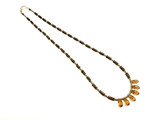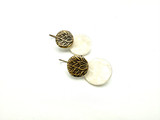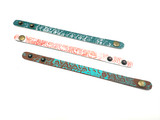Polymer Clay 101
| What is Polymer Clay?Brands & StylesTools & TipsWhere to Buy ItResources | |
| What is Polymer Clay? | |
 Polymer clay is a manmade, non-toxic polymer-based alternative to natural clay. Its only real similarity to natural clay is that it is shaped while soft and then heated for hardening. Owning a kiln is not necessary for polymer-clay work, since the temperatures needed to bake it are easily achieved in a home oven (265° to 275° Fahrenheit). Polymer clay is a manmade, non-toxic polymer-based alternative to natural clay. Its only real similarity to natural clay is that it is shaped while soft and then heated for hardening. Owning a kiln is not necessary for polymer-clay work, since the temperatures needed to bake it are easily achieved in a home oven (265° to 275° Fahrenheit). Each polymer-clay brand is made with its own "recipe," using various resins, plasticizers and other secret ingredients, each optimized for a different usage. You may end up choosing a softer brand for your sculptures or free-form jewelry, and a stiffer brand for millefiori cane work. Although different brands don't guarantee they will mix together exactly the way you expect, many people have successfully mixed brands for desired colors, textures or consistencies. | |
Brands & Styles | |
 Kato PolyClay™ is the polymer clay Rings & Things sells because it offers superior working properties! It's easy to condition, doesn't crumble and doesn't get sticky even after continuous handling. Plus, Kato offers Liquid Polyclay™, which works as a clay extender, softener, adhesive and finishing coat. Kato liquid clear medium allows you to do photo-transfers, create complex grouting effects and make colorful glazes that bake and bond to the clay. Kato PolyClay™ is the polymer clay Rings & Things sells because it offers superior working properties! It's easy to condition, doesn't crumble and doesn't get sticky even after continuous handling. Plus, Kato offers Liquid Polyclay™, which works as a clay extender, softener, adhesive and finishing coat. Kato liquid clear medium allows you to do photo-transfers, create complex grouting effects and make colorful glazes that bake and bond to the clay. Other major brands of polymer clay include Sculpey III® (a soft clay), Premo! Sculpey® (stiffer than Sculpey III, but softer than FIMO®), FIMO (a stiff clay), Cernit and Makins Air-Dry Clay. Generally speaking, softer polymer clays are good for projects that don't involve extensive manipulations. They start out easy to work with, but if you make complex canes, your colors and shapes can start to blend together more than you might want. Stiffer polymer clays may start out crumbly when cold, but they manipulate well in the long run. You can put a few colors in your pocket for a while to warm them before opening the packages. To warm polymer clay in cold weather, you can point a desk lamp at your clay, or place your clay on a heating pad that's set on its lowest setting. No matter what method you use, be careful not to overheat the clay, or it will start to bake. If you live in a cold climate, you may also want to heat your work surface before you start working. Some people have said a blow dryer works well. However, use caution when using a blow dryer (or anything else) for a use other than the manufacturer intended. If you work with polymer clays as a hobby, you can use your regular home oven. Toaster ovens are not recommended, because they don't heat as consistently. If you seriously delve into polymer clays, you will probably want to invest in a second oven, for convenience if not for potential long-term health reasons. All of these polymer clays are non-toxic and well-tested, but it somehow seems foolish to be cooking food in the same oven in which you are daily cooking non-food items... | |
Tools & How-To Tips | |
 | Polymer-clay tools: Choose from several useful and fun polymer-clay tools to expand your design possibilities. We offer everything from basics like blades, rollers and modeling tools, to texture plates, pattern cutters and a molding compound to create your own molds! |
| For general information about what types of polymer clay work best for what type of designs, see "Brands & Styles" above. Tips and how-to hints for working with polymer clay:
| |
Polymer-Clay Resources | |
Polymer Clay Info Links — Updated 2010
 The International Polymer Clay Association (IPCA), formerly the National Polymer clay Guild (NPCG), is a great international source for the latest information on various forms of polyform clay (FIMO, Premo, SculpeyFlex, Cernit, etc.). As of 2008, yearly dues were $30, and included a subscription to their fact filled newsletter, the POLYinforMER. Dues and publication formats have probably changed a little since then, but we just checked their new website, and as of 2019 they are thriving and have some very cool artwork on their website! The International Polymer Clay Association (IPCA), formerly the National Polymer clay Guild (NPCG), is a great international source for the latest information on various forms of polyform clay (FIMO, Premo, SculpeyFlex, Cernit, etc.). As of 2008, yearly dues were $30, and included a subscription to their fact filled newsletter, the POLYinforMER. Dues and publication formats have probably changed a little since then, but we just checked their new website, and as of 2019 they are thriving and have some very cool artwork on their website! For regional polymer clay guilds, see our Bead Societies and Art Guilds page. | |
Oct 27th 2021
Our Bead Blog
-
Edgy Elegance Necklace
Mar 22nd 2024Created by: Guest Designer Deb FlorosSuggested Supplies 1 #20-111-204 TOHO Glass Seed Bead, Size 11
-
Elegant Button Earrings
Mar 22nd 2024Created by: Guest Designer Deb FlorosSuggested Supplies 1 #27-841-042-50 Beadalon Bead Bumper, 1.5m
-
Abstract Painted Cuffs
Feb 26th 2024Created by: Guest Designer Deb FlorosSuggested Supplies 1 #51-810-05-17 Leather Cuff Bracelet, 1/2"




